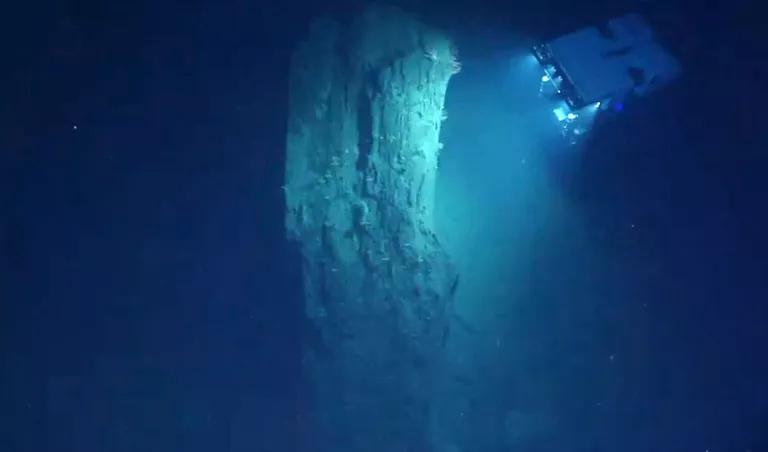Going Deep to Save Our Ocean Treasures
How NRDC helped form an unlikely alliance to help protect 38,000 square miles of unique habitat in the Atlantic.

A feather star crinoid
Just off the Eastern Seaboard of the United States lies a series of deep underwater canyons, home to colorful and rare gardens of cold-water corals, sponges, and anemones. Hudson Canyon, off the New York–New Jersey coast, is a watery Grand Canyon of sorts, nearly as big as the terrestrial version. It provides food, shelter, and nursery areas for a variety of creatures, from exotic, thumb-size deep-sea fish to huge species like the iconic sperm whale.
As a country, we’ve taken strides to protect our natural treasures on land. But what’s out of sight under the ocean’s surface is often out of mind—and under threat by, for example, harmful fishing practices. Fortunately, NRDC and other concerned groups have joined together to protect these valuable ocean ecosystems and to keep them wild for years to come.
Preemptive protection from fishing industry nets
For years, commercial fishing companies have used weighted nets to scoop up seafood along the ocean floor—and any other life that happens to be nearby and cannot get out of the way. “Bottom-tending gear drags across the seafloor and destroys anything in its path,” says Alison Chase, an NRDC senior policy analyst who worked on coral protections alongside NRDC attorney Brad Sewell. “Deep-sea corals—some of which are hundreds to thousands of years old—are particularly vulnerable to such bottom trawls because they grow only millimeters a year. Once this habitat’s gone, it’s not coming back anytime in the foreseeable future.” Use of such harmful fishing gear does not yet extend into the heart of the Hudson Canyon wonderland. But it might in the future as the industry continues its hunt for new fishing grounds and sea life to harvest.
So beginning in 2012, NRDC started coming up with a strategy to protect deep-sea corals and canyons from destructive bottom fishing. It formed a coalition of environmental advocates to encourage the Mid-Atlantic Fishery Management Council to ban destructive fishing gear from coral seas. NRDC also worked to identify protection areas based on where corals had been located or were likely to be found, using information gathered by the National Oceanic and Atmospheric Administration, or NOAA, and its partners during deep-sea dives.

Mapping the canyons, discovering life
When Florida State University scientist Sandra Brooke and colleagues helped map the canyons in 2012 and 2013, they found evidence of previously unknown cold seeps, which Brooke describes as “a hydrothermal vent’s little grandfather—older and a bit slower.”
Highly specialized sea life depends on the vents to survive, including mussels with bacteria in their gills that use the methane for energy. These organisms help fuel rich ecological communities, including sea urchins, sea cucumbers, and crabs. It’s a “food hot spot,” Brooke says.
Corals down there are long-lived and slow-growing, due to the dark, cold water conditions; if they're destroyed, no one knows how long the communities might take to regenerate. Dozens of species of black, Gorgonian, stony, and soft corals inhabit these depths, some so abundant in places that they are referred to as forests.
As they do in rainforests and other complex, land-based ecosystems, layers of life prosper within the canyons. Burrowing tilefish tunnel into clay canyon walls, creating their own underwater condos. Swordfish and sharks prowl for prey. Bioluminescent lanternfish gleam in the dark seas. Squid, lobsters, and a range of endangered and rare whales thrive. In these areas, scientists believe they might find species that could offer pharmacological or technological benefits for humans.
Beautiful images from canyon-mapping research became a powerful tool for Chase as she advocated for strong protections. “The canyons are pitch black, but when we go down there and shine a light, we see they’re made up of crazy shapes, in vibrant pinks and yellows and reds,” she says. “It’s fascinating, the amazing places we’re not seeing, and we don’t spend enough time trying to understand and learn from these places.”

A successful preservation plan
In the summer of 2015, the Mid-Atlantic Fishery Management Council voted to protect 27 named deep-sea canyons in the mid-Atlantic plus a huge swath of surrounding deep-sea habitat. At approximately 38,000 square miles, it’s the largest ocean area in the U.S. Atlantic and Gulf of Mexico safeguarded against destructive fishing gear that hits or scrapes the seafloor.
Chase is pleased with the way that concerned parties—all with different interests—sat down together to hammer out the final lines. It’s not every day that business, environmental, and government interests defend wild places in meaningful ways, using negotiation, compromise, and communication. “I give a lot of credit to the fishermen for being willing to take proactive steps,” she says.
Brooke is also delighted that the canyons are being saved. Although they aren’t as accessible as majestic parks like Yellowstone, they’re just as important, she says. “People appreciate wild places, and they have a place in our collective psyche. Even if we never see them, it’s nice to know they’re there.”
This NRDC.org story is available for online republication by news media outlets or nonprofits under these conditions: The writer(s) must be credited with a byline; you must note prominently that the story was originally published by NRDC.org and link to the original; the story cannot be edited (beyond simple things such as grammar); you can’t resell the story in any form or grant republishing rights to other outlets; you can’t republish our material wholesale or automatically—you need to select stories individually; you can’t republish the photos or graphics on our site without specific permission; you should drop us a note to let us know when you’ve used one of our stories.

How to Become a Community Scientist
In the Melting Arctic, a Reckoning to Save Indigenous Culture, Narwhals, and a Silent Sea
Can Anything Be Done to Stop Overfishing?